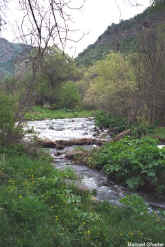|
UNDER
CONSTRUCTION
|
Next
village NE is Narek
(named in 1984 in honor
of the poet Grigor Narekatsi).
|
|
Before leading E into the mountains eventually to reach the Azat
river valley, the road passes
through the small hamlet of Kakavaberd.
Technically in Ararat Marz,
but more accessible from Garni, the remote valleys of the Azat
river and its tributaries shelter Havuts
Tar and Aghjots
Vank (S. Stepanos) Monasteries,
Geghi
Castle
|

|
|
|
|
(Kakavaberd) and
many other interesting complexes and sites. The
Garni cobbled road into the gorge is also the route to reach the
entrance to the Khosrov Nature
Reserve, and an excellent jumping
off point for Havuts Tar.
The preserve takes its name from King Khosrov III, who
ordered the planting of a massive forest to repair centuries of
deforestation. The Khosrov Reserve guards at the gatehouse
beyond may let you in, if you tell them you are visiting the
“Surp” (St. Stepanos
church). Just before the guard house,
clambering up the hill to the left and back, you will find a
footpath that quickly widens, following the contours east about
40 minutes to
Havuts
Tar Monastery,
passing khachkars along the route. A rough dirt track continues
down into the Reserve, running upstream along the Azat river.
At 5 km from the entrance, where Milli Creek (vtak), runs into the Azat from the left, the road straight across
the bridge is closed by a wire (key in house on hill back to
left).
Turning left along an even rougher track brings one in
200 m to Baiburt.
A simple, single-aisle basilica probably of the 5th
c. stands left of the road among ruins of old dwellings of an
Armenian population deported to Persia by Shah Abbas in the 17th
c.
There are allegedly pagan period remains in the vicinity. Another few km uphill past
Baiburt, on a poor jeep track,
is the hamlet of Mets Gilanlar, with a few simple wooden huts.
Turning left just before Gilanlar, the road continues to
a valley across which (20 minutes on foot) are the evocative
ruins of the Aghjots Vank/S. Stepanos Church of the early 13th
century (though founded, according to local legend, by Gregory
the Illuminator on the site of the martyrdom of a certain
Stepanos, companion of St. Hripsime). Opening
the barrier and crossing the bridge to follow the road along the
Azat River, one reaches after a few km a fork back to the right,
which fords the Azat river and leads S over a difficult mountain
track to the hamlt of Kakavaberd and then on to Dvin and the southern part of
the Khosrov Reserve E of Vedi.
Just beyond, a fork left leads to Kyorpikend and to Mets
Gilanlar and another approach to Kakavaberd.
At approximately 8 km from the Bayburd bridge, a stream
across the road forms a barrier to most vehicles. Beyond it on a hill to the left is a ruined hamlet, an
early habitation site.
Somewhere nearby is a ruined medieval church and cluster
of khachkars called Vanstan.
On the sheer summit east of the river is Kakavaberd, more
properly Geghi or Keghi Berd.
This well preserved fortress of the 9th-13th
c. is attested in manuscripts as a family fiefdom of the
Bagratunis, then the Pahlavunis, site of a defeat of the Arab
chieftain Beshr by Gevorg Marzpetuni in 924, and where Prince
Ivane Zakarian took refuge after his defeat by Jalal ad Din
Mingburnu, the last Khwarezm-Shah, near Garni in 1224.
Besides walls and towers, there is a medieval church in
the fortress.
In the vicinity are the S. Astvatsatsin church of Imirzek
and five large dragon monuments
(vishap), carved standing
stones, with designs of bulls and birds.
|